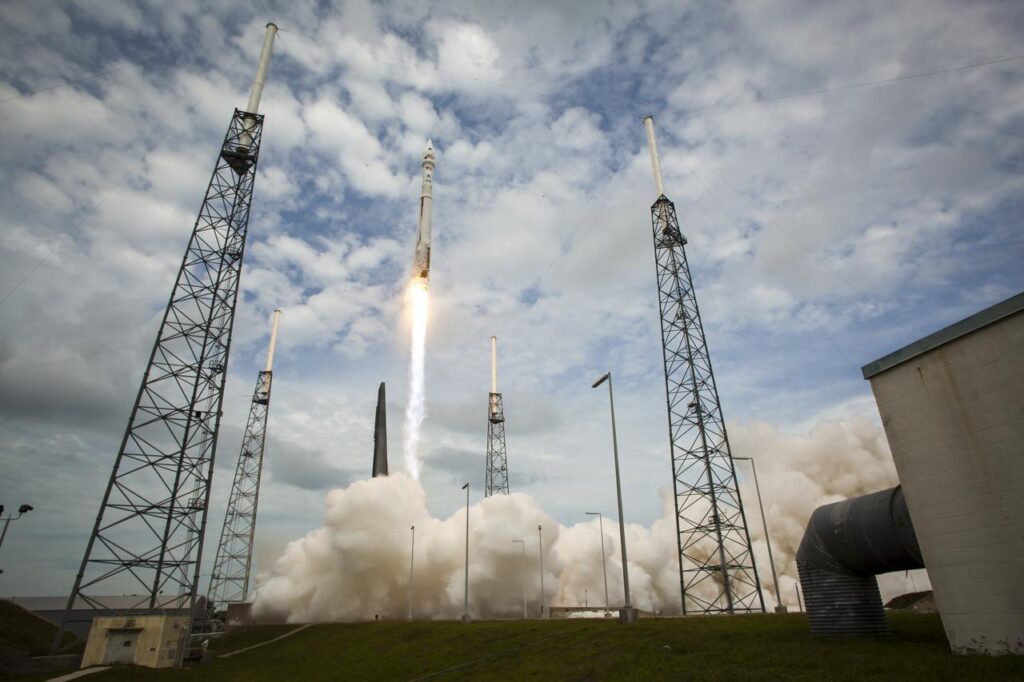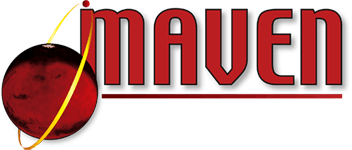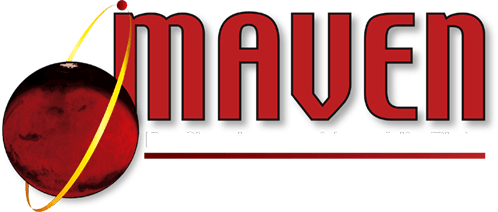
Ten years ago, on November 18, 2013, NASA’s MAVEN (Mars Atmosphere and Volatile Evolution) mission launched from Cape Canaveral on an Atlas V rocket, the first step of its epic nine-month journey to Mars.
The mission has since helped unlock some of the Red Planet’s many mysteries, from how solar wind stripped the planet’s atmosphere to discovering different types of Martian aurora. “Results from the MAVEN mission have transformed our understanding of the planet’s upper atmosphere,” said Shannon Curry, the Principal Investigator of the MAVEN mission. “The mission continues to produce incredible, cross-divisional science, and the team is excited for our future science campaigns and relay activities in the years to come. I have worked on MAVEN since I watched it launch 10 years ago and it has truly been an honor and a privilege.”
To celebrate MAVEN’s launch anniversary, we’re initiating a new T-minus 10 countdown—of stories about what MAVEN team members remember from that special day:
T-10
In 2013, I was in Ann Arbor, MI in my last year of graduate school and starting to apply for postdoc opportunities. I knew several colleagues who were a part of the MAVEN team and followed their adventures to watch the MAVEN launch. I remember receiving updates and photos from friends at the launch site. About two weeks prior to MAVEN’s launch, I submitted a proposal to work with the MAVEN Magnetometer group. What I was most excited about MAVEN was to better understand the role that solar wind dynamics play in shaping the Martian magnetosphere. I had no idea what my chances were but hoped that I could someday work on the mission. Low and behold, I received word that I was accepted into the program two months after launch, and I have been part of the MAVEN team ever since! Gina DiBraccio, NASA GFSC, MAVEN Deputy PI and Project Scientist
T-9
My entire extended family on my mom’s side decided to travel to Cape Canaveral for the launch—about 20 aunts, uncles, and cousins. At this point I was in my fourth year of graduate school and working on MAVEN, and having so many work colleagues and my family in the same place was a bit disorienting! Clouds had rolled in by the time the rocket was ignited, so we only saw it briefly. But from where we were standing on the bleachers, there was a one tiny, blue window in an otherwise overcast sky. Moments after the rocket disappeared, it passed precisely through that gap in the clouds, and we got one more glimpse of MAVEN on its journey. Seeing the rocket again was so unexpected that almost everyone on the bleachers raised their arm to point at it out of surprise: an instinct, perhaps, acknowledging the improbability of a second sighting of this soon-to-be emissary to another world. Mike Chaffin, LASP/CU Boulder, IUVS Echelle Lead
T-8
I was in my last year as a PhD student at Nagoya University, Japan. In those days, I was working hard to write up my PhD thesis and looking for the postdoc position. I was initially planning to visit Kennedy Space Center to see the launch, but I unfortunately had to cancel, because my final postdoc interview was scheduled on the exact same date! So, I watched the MAVEN launch on NASA TV and it was maybe 3am local time. I was so excited that I could not sleep at all. As the result, I had the final postdoc interview with no sleep! Regardless, I was able to excitingly present my research plan, for which the MAVEN observations are essential. Although I was offered the position, I decided to select a different MAVEN postdoc at the University of California Berkeley Space Sciences Laboratory (UCB-SSL). I believe that my experience of the postdoc interview at ISAS/JAXA was helpful for having the subsequent postdoc interview at UCB-SSL! Takuya Hara, UCB-SSL, MAVEN Science Team Member
T-7
I had recently decided to go back to school to become a scientist and had restarted my undergraduate degree that term. I was nervous, so I decided to just take one intro to physics course and lab and see how I did. I ended up doing very well and had a lot of energy and excitement, so I kept going. I never expected I would do a complete U turn on my career and become a scientist, and once I started, I never thought I would do planetary science or be part of a NASA mission. I sort of fell into MAVEN by luck during my grad school visit at University of Colorado Boulder — after talking with a MAVEN team member, I decided to study Mars. I’m very grateful for it because the MAVEN mission and team are excellent, and the broader Mars community has been a wonderful one to do a PhD and be early career in. Ten years ago, I never dreamed I’d be where I am today. I hope the next 10 are even more surprising (in a good way)! Eryn Cangi, LASP/CU Boulder, IUVS instrument team member
T-6
My dad used to say that a successful launch brings good fortune. Peering through the tiny telescope he’d brought to see the launch pad, he and I heard the final callout: “go Atlas, go Centaur, go MAVEN.” The rocket thundered slowly upwards, increasing in speed through the clouds and was soon out of sight. A successful launch. My first launch. Four years before that day, I was interviewed and brought onto the team as an undergraduate researcher. I eagerly accepted the challenge to build a simulation that could trace charged particles bombarding the Martian atmosphere. Ultimately, observations from MAVEN could be put into the simulation to predict how the atmosphere changed over millennia. However, this meant that the simulation — my career — would only be realized if and when MAVEN arrived at Mars. Luckily, MAVEN did enter orbit around Mars, and my simulation became the crown jewel of my PhD research at CU Boulder. I presented my thesis in December 2021 over Zoom, which allowed my father, then home-bound with Stage IV cancer, to be there. It has been over a year since he passed away. I miss him terribly, and I am deeply grateful we had that day at Cape Canaveral. When the Atlas V entered the clouds, he said this was a good launch and that this would be the first of many in my career. I will look forward to those days as I continue my path and will remember him at each one. Rebecca Jolitz, UCB-SSL, Postdoctoral Researcher
T-5
I was at Jetty Park at Port Canaveral with my family. Launch happened right around noon local time, which was peak “nap time” for my two-year-old son. We saw the launch go off through the clouds and immediately returned to our rental for his nap. I may or may not have also taken one. Jasper Halekas, University of Iowa, SWIA instrument lead
T-4
I had been hired to join the NGIMS instrument team a month before launch, and I was finishing a post-doc in Virginia. I was invited to join the launch and the science team meeting in Florida to meet everyone and get to know the mission. My mother lives in central Florida and was able to join us for the launch as well. It was very exciting to be part of the first science team meeting as well as the launch. I was also asked to participate in some of the many outreach activities the scientists and engineers were doing at Kennedy in preparation for the launch. I was even interviewed with a panel on NASA TV! Meredith Elrod, NASA GSFC/UMD, NGIMS deputy instrument lead
T-3
I remember that it was a whirlwind leading up to the launch between pre-launch reviews, science team meetings, and speaking at public events. Then, as I finally watched the first launch that I’d ever witnessed up close, and knowing all of the MAVEN team’s blood, sweat, and tears that went into the spacecraft – it brought tears to my eyes. Having studied ozone on Mars from the ground using a single channel instrument, I was looking forward to seeing the global ozone maps that MAVEN would produce, and they have been absolutely amazing. After watching the launch and spending the afternoon helping to field the many post-launch press inquiries, I just needed some quiet time to take it all in. So I walked the beach alone, listening to music and reflecting on such an amazing day. Kelly Fast, NASA HQ, former MAVEN Program Scientist
T-2
On launch day, I was in the launch control center sitting between Dr. Bruce Jakosky (MAVEN PI) and Nick Jedrich (MAVEN Observatory Manager). With a “3-2-1-Liftoff”, MAVEN was on its way onboard the Atlas V launch vehicle. There is nothing like the feeling of being on console and seeing the rocket launching from the screen in front of you and then a few seconds later, hearing the roar outside and feeling the building trembling from the launch event. Everything continued smoothly through launch and spacecraft separation. However, the euphoria subsided a bit when we didn’t immediately receive telemetry confirming solar array deployment and spacecraft “power positive” at the expected time. Such timelines are merely estimates, so it was not a huge surprise, but as seconds ticked by, we stood by with growing anxiousness. During this waiting period, the door behind me in the launch control room opened, and in walked NASA Administrator Charlie Bolden along with a few other senior officials. My heart rate sped up as he stood behind me, eagerly waiting to hear that MAVEN was safely on its way to Mars. Within a long minute or two, I was given the exciting news that the solar arrays had deployed, and everything was nominal. I turned to Administrator Bolden and gave him the happy news. Cheers, smiles, and handshakes erupted all around! It truly was a highlight of my NASA career. Dave Mitchell, NASA GSFC, former MAVEN Project Manager
T-1
As principal investigator for the MAVEN mission, I was at a console in the control room for the launch. During the countdown, there is an automatic hold at T-4 minutes. That’s a natural spot when everything on the rocket is stable, and it can wait there for hours if necessary for technical issues or weather to clear up. During the hold, I listened to the final poll from people representing all key systems to make sure they were ready for launch. When we were cleared to resume the countdown, time slowed down. It was four minutes of second-by-second waiting. I was so anxious that I couldn’t sit still. I immediately understood why there was a bar across the top of the console — it was something to grab on to! The countdown reached the last ten seconds, the rocket ignited, and the Atlas V carrying the MAVEN spacecraft lifted off. It was a flawless countdown and a picture-perfect launch. Bruce Jakosky, LASP/CU Boulder, former-Principal Investigator of MAVEN and Research Scientist

